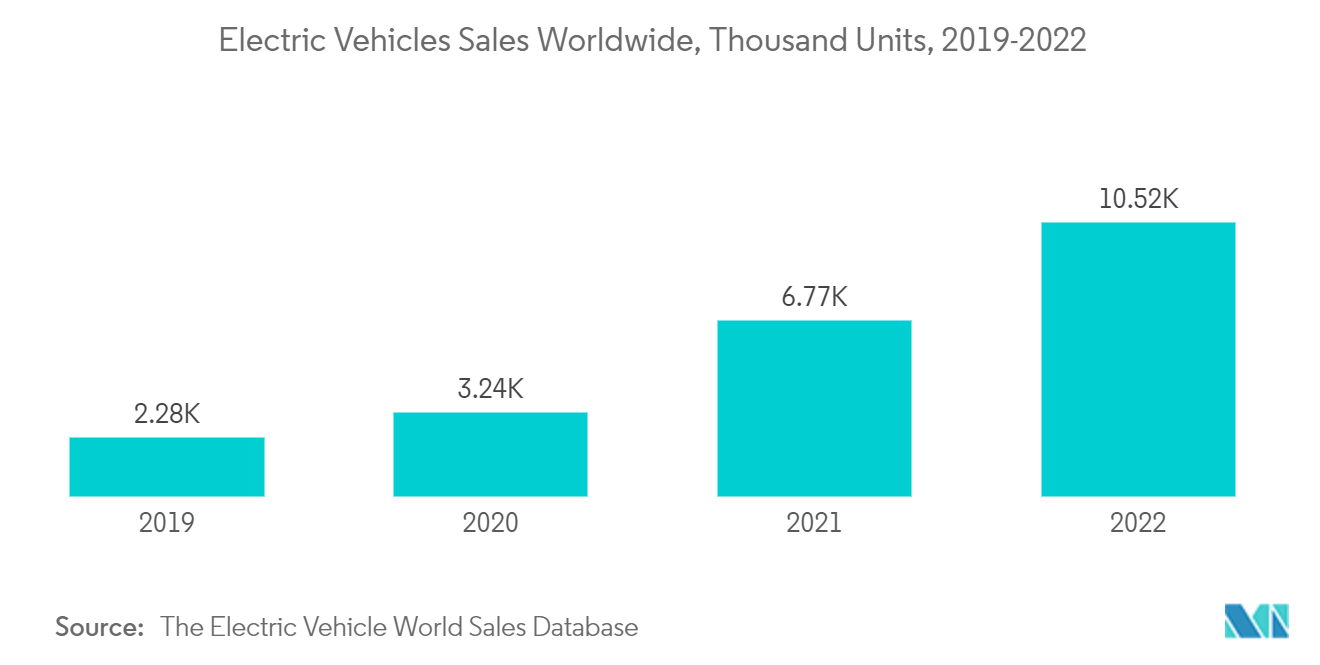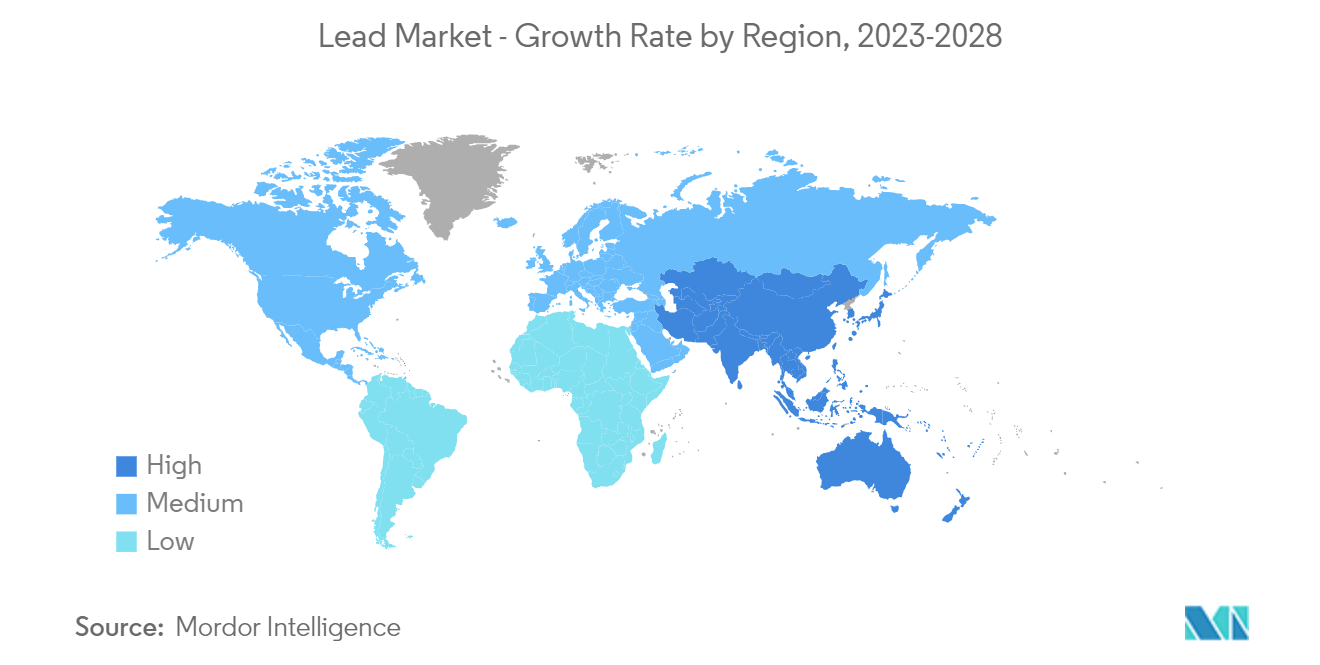Market Trends of Lead Industry
Battery Segment is Expected to Dominate the Market
- Lead and lead compounds have been used in various home products, including paint, ceramics, batteries, etc. Batteries hold the largest share of lead usage as it makes it most reliable. Lead batteries are inexpensive and renewable energy sources and are thus considered eco-friendly.
- The increasing demand for motor vehicles and growth in using renewable energy sources with the need for storage batteries is directly proportional to the increasing demand for lead-acid batteries. The batteries contain large amounts of lead as solid metal or lead-oxide powder. An average battery can contain up to 10 kilograms of lead.
- As per the United Nations Environment Programme (UNEP), approximately 86% of the total global consumption of lead is for producing lead-acid batteries mainly used in motorized vehicles, storage of energy generated by photovoltaic cells and wind turbines, and backup power supplies.
- According to International Lead and Zinc Study Group (ILZSG), in 2022, the global demand for refined lead metal exceeded supply by 99 kilotonnes. In 2022, refined lead metal production from recycled raw material accounted for 65.5% of global production, compared to 65.1% in the previous year.
- Lead-acid batteries are used in the form of starting, lighting, and ignition (SLI) batteries, stationary batteries (telecom, UPS, energy storage systems (ESS), etc.), portable batteries (consumer electronics, etc.), and more.
- It is commonly used as an automotive battery for starting the engine and as the main energy source for electric vehicles such as motorized wheelchairs, golf carts, and electric scooters.
- According to International Energy Agency (IEA) report, in 2022, 10.5 million electric cars were sold worldwide, and the sales are expected to grow by another 35% to reach 14 million. The total vehicle sales reached 73.8 million, with electric cars accounting for 14.2%.
- As per the World Economic Forum (WEF), nearly 4.3 million new battery-powered EVs (BEVs) and plug-in hybrid electric vehicles (PHEVs) were sold globally in the first half of 2022, enhancing the demand for materials such as lead used in batteries.
- Therefore, the aforementioned factors are expected to impact the lead market in the coming years significantly.

Asia-Pacific Region is Expected to Dominate the Market
- Asia-Pacific is expected to dominate the lead market, with the majority of the demand coming from China, Japan, and India.
- Lead-acid batteries are used in electric vehicles (EVs), mainly commercial EVs, to supplement other ancillary loads. China is currently the largest market for electric vehicles. In April 2022, new energy vehicle sales amounted to 299,000 units in China. Out of the total sales units, 280,000 were passenger electric vehicles, and 19,000 were commercial electric vehicles.
- The government of China is working on various initiatives focused on the development of small and affordable electric vehicle models. Some of the EVs' prices have been kept below USD 10,000, which caters to a wider audience due to their affordability.
- Many large electric vehicle manufacturers are investing in the establishment of plants for the production of electric vehicles in the country. For instance, in February 2022, Tesla built a second electric vehicle (EV) facility in China to help it keep up with increasing demand both locally and in export markets. The company increased its capacity in China to at least 1 million cars per year.
- In January 2022, Honda, in partnership with Dongfeng Motor, announced plans to build a second assembly plant for all-electric vehicles in China. The manufacturing at the plant is expected to begin in 2024, with an initial annual capacity of 120,000 vehicles.
- Various government initiatives taken by countries are helping boost the demand for electric vehicles. The government of India has undertaken multiple initiatives to promote the manufacturing and adoption of electric vehicles in India to reduce emissions in accordance with international conventions and develop e-mobility in the wake of rapid urbanization.
- Thailand is also slowly emerging as a hub for EVs and hybrid vehicles. In 2022, the hybrid EV sales volume in Thailand reached almost 42,000, the highest among other types of EVs. According to the Federation of Thai Industries (FTI), in 2023, Thailand's EV market will continue to gain momentum, with sales expected to reach between 25,000 and 35,000 units.
- In the construction industry, lead is commonly used as a specialist material. It can be found in construction materials, such as paints, coatings, concrete, mortar, solder, and sheet metal.
- As per the U.S. International Trade Administration, China is the world's largest construction market and is forecasted to grow at an annual average rate of 8.6% till 2030. According to National Development and Reform Commission (NDRC) data, China has planned an investment of USD 1.43 trillion in the coming years till 2025 in some of the major construction projects.
- The Japanese construction industry is expected to boom due to some major events to be hosted in the country. The World Expo will be hosted by Osaka in 2025. The country built high-rise towers, a 37-story, 230m tall office tower for Tokyo Stations in 2021. The construction of a 61-storey, 390-m tall office tower is due for completion in 2027
- Therefore, the aforementioned factors are expected to have a significant impact on the lead market in the region in the coming years.


